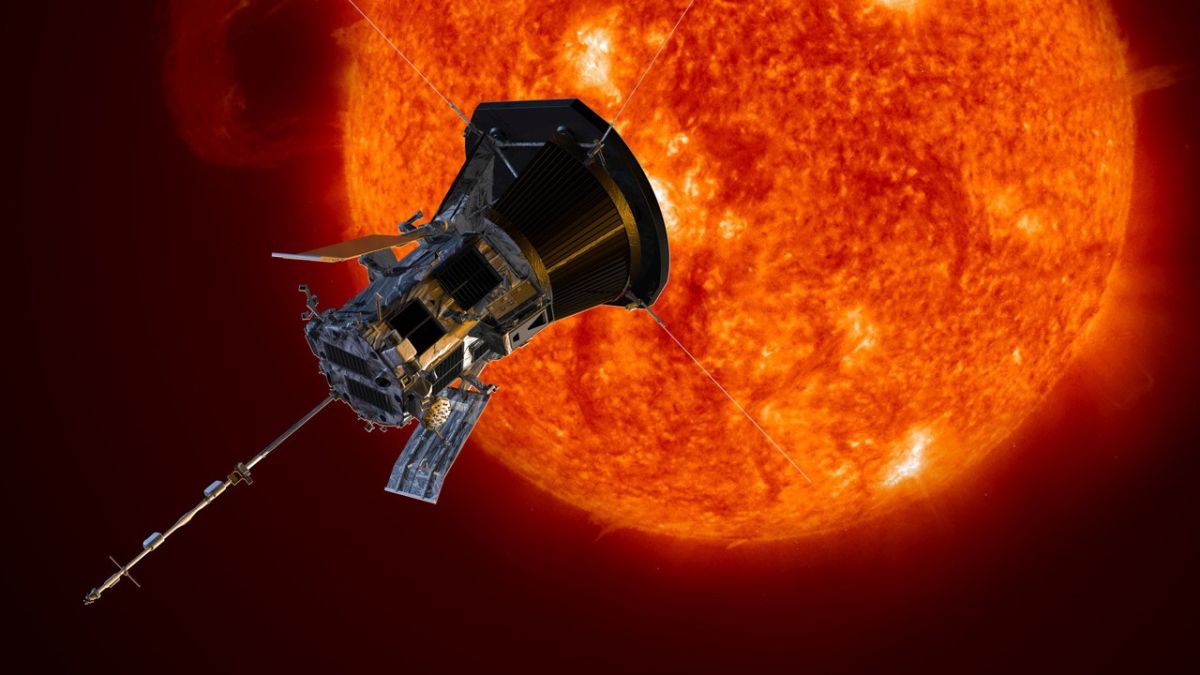Here is something that you might remember from your high school earth science class: As sunlight — which appears to be pure white — passes through a glass prism, it refracts or bends. Different wavelengths of light are bent by different amounts. In this way a prism can spread out a ray of white light into the rainbow spectrum. The spread of refractive colors can be observed in poor-quality binoculars and telescopes. In such inexpensive instruments the optics tend to be not aligned properly so sometimes you’ll see the full…
Read MoreMonth: June 2023
NASA’s Parker Solar Probe starts summer with 16th swoop by the sun
NASA’s most advanced spacecraft for solar exploration just made another close flyby of the sun. The Parker Solar Probe conducted its 16th perihelion pass on Thursday morning (June 22), cruising through the sun’s superhot outer atmosphere, called the corona. As the spacecraft flies through the corona’s blazing plasma, where temperatures can climb above 1.8 million degrees Fahrenheit (1 million degrees Celsius), the instruments onboard the probe are kept at a comfortable 85 degrees F (29.4 degrees C). This is due to the probe’s heat shield, which is 4.5 inches (11.4…
Read MoreWatch a house-size asteroid zoom past Earth live on June 25
Earth is about to have a close encounter with a space rock. On Sunday (June 25), the near-Earth asteroid 2023 MU2 will pass within 134,000 miles (215,000 kilometers) of Earth, or just about 60% of the average distance from our planet to the moon. While this flyby is fairly close in astronomical terms, the space rock isn’t likely to pose any threat to Earth or spacecraft in its orbit. According to the NASA/JPL Center for Near Earth Object Studies (CNEOS), the asteroid is estimated to be between 13 and 29…
Read MoreNASA Welcomes India as 27th Artemis Accords Signatory
During a ceremony at the Willard InterContinental Hotel in Washington on Wednesday, June 21, India became the 27th country to sign the Artemis Accords. NASA Administrator Bill Nelson participated in the signing ceremony for the agency and Taranjit Singh Sandhu, India’s ambassador to the United States, signed on behalf of India.
Read MoreYou’ve never seen Mars like this. Amazing NASA photos reveal Red Planet in ultraviolet light
NASA’s Mars Atmosphere and Volatile EvolutioN (MAVEN) mission captured ultraviolet views of the planet at different points along its orbit around the sun. (Image credit: NASA/LASP/CU Boulder) New ultraviolet photos of Mars offer stunning views of the planet’s changing seasons. Astronomers using NASA’s Mars Atmosphere and Volatile EvolutioN (MAVEN) spacecraft photographed the Red Planet in July 2022, during the southern hemisphere’s summer season when the planet was closest to the sun, and then again in January 2023 after Mars‘ northern hemisphere had passed the farthest point in its orbit from…
Read MoreNASA Awards Millions in STEM Research Grants
NASA announced the recipients of its annual STEM grants, providing nearly $4 million in total funding, to support scientific and technical research that aligns with the agency’s strategic research and technology development priorities. By providing resources to support cutting-edge research in STEM, NASA helps create a stronger and more vibrant sci
Read MoreSpace Station Science Highlights: Week of June 19, 2023
Crew members aboard the International Space Station conducted scientific investigations during the week of June 19 that included evaluating the behavior of liquids in a tank, demonstrating radiation-sensing technology, and examining solidification of metallic alloys in microgravity.
Read MoreNASA Invites Media to Cover Asteroid Sample Return, Logistics Call
NASA’s OSIRIS-REx (Origins, Spectral Interpretation, Resource Identification and Security – Regolith Explorer) mission will deliver the agency’s first asteroid sample collected in space to Earth on Sept. 24, 2023. Media interested in covering the landing, as well as mission activities leading up to and following the return, are invited to register
Read MoreHubble Glimpses a Glistening Cluster
The teeming stars of the globular cluster NGC 6544 glisten in this image from the NASA/ESA Hubble Space Telescope.
Read MoreRussian cosmonauts toss old equipment overboard on ISS spacewalk
Two Russian cosmonauts spent six hours outside the International Space Station on Thursday (June 22) cleaning up the exterior of the orbiting laboratory by removing and tossing overboard a trio of no longer needed devices, including a spent science experiment. Expedition 69 commander Sergey Prokopyev and flight engineer Dmitry Petelin, both of Russia’s federal space corporation Roscosmos, exited the space station’s Poisk module at 10:24 a.m. EDT (1424 GMT) on Thursday. In addition to jettisoning hardware, the spacewalk also included the installation of a new stanchion for high-speed telemetry equipment…
Read More